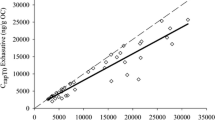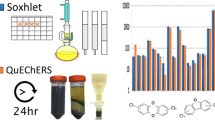Abstract
It is well understood that bioavailability-based estimates of exposure are more accurate than traditionally used techniques. One method is the use of Tenax extractable concentrations. This technique uses Tenax, a porous polymer resin, to quantify the amount of hydrophobic organic contaminant that desorbs from sediment. This labile fraction is representative of exposure to benthic organisms and correlates with bioaccumulation and toxicity for several compounds and species. There are two general ways to compare Tenax extractable concentrations to exposure: determining the rapidly desorbing fractions using sequential extractions and using a fixed time single-point extraction. These extractions can be conducted by mixing small masses of sediments (typically <3 g) in overlying water with small masses of Tenax (~0.5 g) and mixing this matrix for fixed periods. The amount of sediment and Tenax can be altered to account for differences in organic carbon and contaminant concentrations. Since the Tenax floats, it can easily be removed from the matrix, and the compounds of interest can be extracted from the beads. These values are normalized for the proportion of organic carbon and compared to lipid-normalized tissue concentration or toxicity values. While there are some limitations to the method, it provides a rapid, accurate, cost-effective means of comparing and evaluating risk of hydrophobic organic contaminants in sediments.
Access this chapter
Tax calculation will be finalised at checkout
Purchases are for personal use only
Similar content being viewed by others
References
Semple KT, Doick KJ, Jones KC, Burauel P, Craven A, Harms H (2004) Defining bioavailability and bioaccessibility of contaminated soil and sediment is complicated. Environ Sci Technol 38(12):228A–231A
DiToro DM, Zarba CS, Hansen DJ, Berry WJ, Swartz RC, Cowan CE, Pavlou SP, Allen HE, Thomas NA, Paquin PR (1991) Technical basis for establishing sediment quality criteria for nonionic organic chemicals by using equilibrium partitioning. Environ Toxicol Chem 10:1541–1586
Harwood AD, Nutile SA, Landrum PF, Lydy MJ (2015) Tenax extraction as a simple approach to improve environmental risk assessments. Environ Toxicol Chem 34(7):1445–1453
Lydy MJ, Harwood AD, Nutile SA, Landrum PF (2015) Tenax extraction of sediments to estimate desorption and bioavailability of hydrophobic contaminants: a literature review. Integr Environ Assess Manag 11(2):208–220
Ahlf W, Förstner U (1999) Managing contaminated sediments. J Soil Sediment 1(1):30–36
Pignatello JJ, Xing B (1996) Mechanisms of slow sorption of organic chemicals to natural particles. Environ Sci Technol 30:1–11
Bucheli TD, Gustafsson Ö (2000) Quantification of the soot-water distribution coefficient of PAHs provides mechanistic basis for enhanced sorption observations. Environ Sci Technol 34:5144–5151
Jonker MT, Koelmans AA (2002) Extraction of polycyclic aromatic hydrocarbons from soot and sediment: solvent evaluation and implications for sorption mechanism. Environ Sci Technol 36:4107–4113
Lamoureux EM, Brownawell BJ (2004) Influence of soot on hydrophobic organic contaminant desorption and assimilation efficiency. Environ Toxicol Chem 23:2571–2577
Cornelissen G, Gustafsson Ö, Bucheli TD, Jonker MT, Koelmans AA, van Noort PC (2005) Extensive sorption of organic compounds to black carbon, coal, and kerogen in sediments and soils: mechanisms and consequences for distribution, bioaccumulation, and biodegradation. Environ Sci Technol 39:6881–6895
Peng W, Fang ZD, Qiao H, Shi YG, Hao QL, Zhang K, Fu GY (2015) Sorption–desorption and dynamic characteristics of polychlorinated biphenyls on humic acid. J Chem Eng Japan 48:592–599
Sinche FL, Nutile SA, Huff Hartz KE, Landrum PF, Lydy MJ (2018) Effects of type and quantity of organic carbon on bioaccessibility of polychlorinated biphenyls in contaminated sediments. Environ Toxicol Chem 37(5):1280–1290
Reichenberg F, Mayer P (2006) Two complementary sides of bioavailability: accessibility and chemical activity of organic contaminants in sediments and soils. Environ Toxicol Chem 25(5):1239–1245
Nutile SA, Harwood AD, Sinche FL, Huff Hartz KE, Landrum PF, Lydy MJ (2017) The robustness of single-point Tenax extractions of pyrethroids: effects of the Tenax to organic carbon mass ratio on exposure estimates. Chemosphere 171:308–317
Sinche FL, Nutile SA, Landrum P, Lydy MJ (2017) Optimization of Tenax extraction parameters for polychlorinated biphenyls in contaminated sediments. Talanta 164:386–395
Kamble ST, Saran RK (2005) Effect of concentration on the adsorption of three termiticides in soil. Bull Environ Contam Toxicol 75:1077–1085
Mukherjee I, Singh R, Govil JN (2010) Risk assessment of a synthetic pyrethroid, bifenthrin on pulses. Bull Environ Contam Toxicol 84:294–300
Maul JD, Trimble AJ, Lydy MJ (2008) Partitioning and matrix-specific toxicity of bifenthrin among sediments and leaf-sourced organic matter. Environ Toxicol Chem 27(4):945–952
Weston DP, Holmes RW, You J, Lydy MJ (2005) Aquatic toxicity due to residential use of pyrethroid insecticides. Environ Sci Technol 39(24):9778–9784
Amweg EL, Weston DP, You J, Lydy MJ (2006) Pyrethroid insecticides and sediment toxicity in urban creeks from California and Tennessee. Environ Sci Technol 40:1700–1706
Trimble TA, Weston DP, Belden JB, Lydy MJ (2009) Identification and evaluation of pyrethroid insecticide mixtures in urban sediments. Environ Toxicol Chem 28(8):1687–1695
Hintzen EP, Lydy MJ, Belden JB (2009) Occurrence and potential toxicity of pyrethroids and other insecticides in bed sediments of urban streams in central Texas. Environ Pollut 157:110–116
Ding YP, Harwood AD, Foslund HM, Lydy MJ (2010) Distribution and toxicity of sediment-associated pesticides in urban and agricultural waterways from Illinois, USA. Environ Toxicol Chem 29(1):149–157
Harwood AD, Landrum PF, Weston DP, Lydy MJ (2013) Using SPME fibers and Tenax to predict bioavailability of pyrethroids and chlorpyrifos in field sediments. Environ Pollut 173:47–51
Pignatello JJ (1990) Slowly reversible sorption of aliphatic halocarbons in soils. I. Formation of residual fractions. Environ Toxicol Chem 9:1107–1115
Pignatello JJ (1990) Slowly reversible sorption of aliphatic halocarbons in soils. II. Mechanistic aspects. Environ Toxicol Chem 9:1117–1126
Pignatello JJ (1991) Desorption of tetrachloroethene and 1,2-dibromo-3-chloropropane from aquifer sediments. Environ Toxicol Chem 10:1399–1404
Cornelissen G, Van Noort PCM, Govers HAJ (1997) Desorption kinetics of chlorobenzenes, polycyclic aromatic hydrocarbons, and polychlorinated biphenyls: sediment extraction with Tenax® and effects of contact time and solute hydrophobicity. Environ Toxicol Chem 16(7):1351–1357
Cornelissen G, Rigterink H, ten Hulscher DEM, Vrind BA, Van Noort PCM (2001) A simple Tenax extraction method to determine the availability of sediment-sorbed organic compounds. Environ Toxicol Chem 20:706–711
You J, Harwood AD, Li H, Lydy MJ (2011) Chemical techniques for assessing bioavailability of sediment-associated contaminants: SPME versus Tenax extraction. J Environ Monit 13:792–800
Xu Y, Gan J, Wang Z, Spurlock F (2008) Effect of aging on desorption kinetics of sediment-associated pyrethroids. Environ Toxicol Chem 27:1293–1301
Nutile SA, Harwood AD, Sinche FL, Huff Hartz KE, Landrum PF, Lydy MJ (2017) Methodological and environmental impacts on bioaccessibility estimates provided by single-point Tenax extractions. Arch Environ Contam Toxicol 72(4):612–621
Kraaij RH, Ciarelli S, Tolls J, Kater BJ, Belfroid A (2001) Bioavailability Corophium volutator of lab-contaminated and native polycyclic aromatic hydrocarbons to the amphipod relates to chemical desorption. Environ Toxicol Chem 20:1716–1774
Kraaij R, Seinen W, Tolls J, Cornelissen G, Belfroid AC (2002) Direct evidence of sequestration in sediments affecting the bioavailability of hydrophobic organic chemicals to benthic deposit-feeders. Environ Sci Technol 36:3525–3529
ten Hulscher TEM, Postma J, Den Besten PJ, Stroomberg GJ, Belfroid A, Wegener W, Faber JH, Van Der Pol JC, Jan Hendriks A, Van Noort PCM (2003) Tenax extraction mimics benthic and terrestrial bioavailability of organic compounds. Environ Toxicol Chem 22:2258–2265
You J, Landrum PF, Lydy MJ (2006) Comparison of chemical approaches for assessing bioavailability of sediment-associated contaminants. Environ Sci Technol 40:6348–6353
Landrum PF, Robinson SD, Gossiaux DC, You J, Lydy MJ, Mitra S, ten Hulscher TEM (2007) Predicting bioavailability of sediment-associated contaminants for Diporeia spp. oligochaetes. Environ Sci Technol 41:6442–6447
You J, Pehkonen S, Weston DP, Lydy MJ (2008) Chemical availability and sediment toxicity of pyrethroid insecticides to Hyalella Azteca: application to field sediment with unexpectedly low toxicity. Environ Toxicol Chem 27(10):2124–2130
Harwood AD, Landrum PF, Lydy MJ (2012) Can SPME and Tenax methods predict the bioavailability of biotransformed insecticides? Environ Sci Technol 46:2413–2419
Mackenbach EM, You J, Mills MA, Landrum PF, Lydy MJ (2012) Application of a Tenax model to assess bioavailability of PCBs in field sediments. Environ Toxicol Chem 31:1–7
Du J, Pang J, You J (2013) Bioavailability-based chronic toxicity measurements of permethrin to Chironomus dilutus. Environ Toxicol Chem 32:1403–1411
Harwood AD, Landrum PF, Lydy MJ (2013) Bioavailability-based toxicity endpoints of bifenthrin for Hyalella azteca and Chironomus dilutus. Chemosphere 90:1117–1122
Du J, Li Y, Huang ZC, You J (2014) Chronic toxicity thresholds for sediment-associated benzo[a]pyrene in the midge (Chironomus dilutus). Arch Environ Contam Toxicol 66:370–378
Mackenbach EM, Harwood AD, Mills MA, Landrum PF, Lydy MJ (2014) Application of a Tenax model to assess bioavailability of polychlorinated biphenyls in field sediments. Environ Toxicol Chem 33:286–292
Smith ME, Lazorchak JM, Herrin LE, Brewer-Swartz S, Thoeny WT (1997) A reformulated, reconstituted water for testing the freshwater amphipod, Hyalella azteca. Environ Toxicol Chem 16(6):1229–1233
Yang Y, Hunter W, Tao S, Gan J (2008) Relationships between desorption intervals and availability of sediment-associated hydrophobic contaminants. Environ Sci Technol 42:8446–8451
Cornelissen G, Rigterink H, Ferdinandy MMA, Van Noort PCM (1998) Rapidly desorbing fractions of PAHs in contaminated sediments as a predictor of the extent of bioremediation. Environ Sci Technol 32:966–970
Kukkonen JVK, Landrum PF, Mitra S, Gossiaux DC, Hunnarsson J, Weston D (2004) The role of desorption for describing the bioavailability of select polycyclic aromatic hydrocarbon and polychlorinated biphenyl congeners for seven laboratory-spiked sediments. Environ Toxicol Chem 23:1842–1851
You J, Pehkonen S, Landrum PF, Lydy MJ (2007) Desorption of hydrophobic compounds from laboratory-spiked sediments measured by Tenax absorbent and matrix solid-phase microextraction. Environ Sci Technol 41:5672–5678
Sormunen AJ, Koistinen J, Leppänen MT, Kukkonen JVK (2008) Desorption of sediment associated polychlorinated dibenzo-p-dioxins, dibenzofurans, diphenyl ethers and hydroxydiphenyl ethers from contaminated sediment. Chemosphere 72:1–7
Trimble TA, You J, Lydy MJ (2008) Bioavailability of PCBs from field-collected sediments: application of Tenax extraction and matrix-SPME techniques. Chemosphere 71:337–344
You J, Brennan A, Lydy MJ (2009) Bioavailability and biotransformation of sediment-associated pyrethroid insecticides in Lumbriculus variegatus. Chemosphere 75:1477–1482
Archer MC, Harwood AD, Nutile SA, Huff Hartz KE, Mills MA, Garvey JE, Lydy MJ (2018) The value of using multiple metrics to evaluate PCB exposure. Arch Environ Contam Toxicol 74(3):361–371
Author information
Authors and Affiliations
Corresponding author
Editor information
Editors and Affiliations
Rights and permissions
Copyright information
© 2019 Springer Science+Business Media, LLC
About this protocol
Cite this protocol
Harwood, A.D., Nutile, S.A. (2019). Using Tenax Extractable Concentrations to Determine the Bioavailable Contaminant Fraction in Sediments. In: Seiler, TB., Brinkmann, M. (eds) In Situ Bioavailability and Toxicity of Organic Chemicals in Aquatic Systems. Methods in Pharmacology and Toxicology. Humana, New York, NY. https://doi.org/10.1007/7653_2019_41
Download citation
DOI: https://doi.org/10.1007/7653_2019_41
Published:
Publisher Name: Humana, New York, NY
Print ISBN: 978-1-0716-2352-7
Online ISBN: 978-1-0716-2353-4
eBook Packages: Springer Protocols




